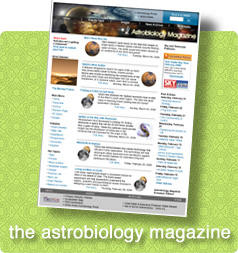-
Invisible Yellowstone
Research conducted in Yellowstone National Park by astrobiologists from NAI’s Montana State Team is highlighted in the 30-minute film Invisible Yellowstone, produced by MSU’s Thermal Biology Institute and MSU’s Science and Natural History filmmaking program. The film is available on DVD by contacting Daniella Scalice at daniella.m.scalice@nasa.gov
-
NPR's Science Friday on Origins of Life and the Universe
National Public Radio’s Science Friday broadcasted live from Arizona State University on Friday, April 3rd as part of their Origins Symposium. The symposium, which inaugurated ASU’s new Origins Initiative, featured world renowned scientists Stephen Hawking, Steven Pinker, Richard Dawkins, and Craig Venter. The Science Friday broadcast included two panels: Physicists and the Origin of the Universe, and Origins and Evolution of Life. Listen to the archive here.
-
Hydrogenase Active Sites and the Origin of Life
Members of NAI’s Team at Montana State University have provided a Perspectives piece in Dalton Transactions reviewing the organo-metallic chemistry of the active sites of hydrogenase enzymes. Since hydrogen metabolism is presumed to be an early feature in the energetics of life, and hydrogen metabolizing organisms can be traced very early in molecular phylogeny, studying the metal clusters at hydrogenase active sites can reveal potential conditions in which early life arose. Efforts in this field also could have significant impacts on alternative and renewable energy solutions.
-
How Life Shatters Chemistry's Mirror
Handedness, or “chirality,” is when molecules come in two forms that are mirror images of each other, like right- and left-handed gloves. Even though chiral molecules are produced equally in nature, life seems to prefer one hand over the other. The reason for this is a mystery that scientists are struggling to answer.
Source: [Astrobiology Magazine]
-
NASA's 21st Annual Planetary Science Summer School
NASA is accepting applications from science and engineering post-docs, recent PhDs, and doctoral students for its 21st Annual Planetary Science Summer School, which will hold two separate sessions this summer (20-24 July and 3-7 August 2009) at the Jet Propulsion Laboratory in Pasadena, Calif. Applications are due 1 May 2009.
During the program, student teams will carry out the equivalent of an early mission concept study, prepare a proposal authorization review presentation, present it to a review board, and receive feedback. At the end of the week, students will have a clearer understanding of the life cycle...
-
Fragments of Asteroid Impact are Collected and Analyzed

Never before has an asteroid been both telescopically observed while in space, and then collected and analyzed after it’s hit the Earth. NAI astrobiologists from the Carnegie Institution of Washington and the SETI Institute are part of the large, interdisciplinary team of scientists who undertook the investigation. Their results are published in a recent issue of Nature.Analysis of the carbon content in the fragments of 2008 TC3, as it is known, showed it to be mostly graphite-like, indicating that at some point in the past, the body had been subjected to extremely...
-
Early Oxygen

Cores retrieved from layers of deep-sea rocks that are 3.46 billion years old suggest that oceans contained abundant oxygen and that the atmosphere of the Earth was as rich in oxygen as it is today. The cores were obtained in northwestern Western Australia, and contain evidence that the deep ocean 3.46 billion years ago was so rich in oxygen that oxygen-producing organisms must have been actively producing it. This means that oxygen-producing organisms like cyanobacteria were present much earlier in Earth’s history than previously believed.Source: [Astrobiology Magazine]
 Planetary Science Decadal Survey
Planetary Science Decadal Survey 2008 Annual Report
2008 Annual Report- NASA Selects New Science Teams for Astrobiology Institute
 NAI Team Overview Presentations
NAI Team Overview Presentations- 2008 Astrobiology Roadmap
- 2009 Santander Summer School
- NRC Assessment of the NASA Astrobiology Institute, 2008
- Astrobiology Small Payloads Workshop Report
- Seminar Series Podcasts
- Astrobiology Primer
- NASA Postdoctoral Program Selections
- NPR's Science Friday on Origins of Life and the Universe
- NAI Team Overview Seminars Continue in April
- Recently Published Research from the NAI
- 2009 Santander Summer School: NAI Scholarship Deadline Extended to April 24th
- 21st Annual Planetary Science Summer School
- Invisible Yellowstone
- Beyond the Edge of the Sea Traveling Art Exhibition
- New Frontiers Announcement of Opportunity
 April 9, 2009
April 9, 2009 





